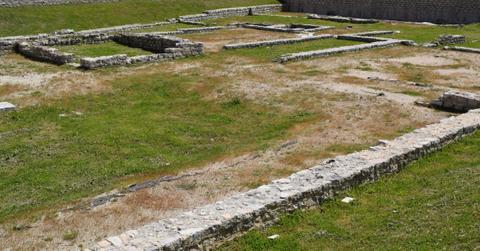Golden Graves: 57 Bejeweled Tombs Uncovered in Ancient Roman Burial Ground

Archaeologists have uncovered a Roman necropolis after conducting a two-year excavation at the site of a planned solar energy plant.
Aug. 26 2024, Published 1:01 p.m. ET
During a two-year excavation at the planned site for a solar energy plant, archaeologists recently made a remarkable discovery: a Roman necropolis containing 57 large and intricately decorated tombs where 67 skeletons were buried dressed in golden jewelry and expensive leather shoes, according to sources.
The ancient burial ground, located near the ancient city of Tarquinia, approximately 50 miles northwest of Rome, is believed to date back to the second and fourth centuries, according to CNN.
The shock of the archaeological team is not only due to the sheer number of riches found alongside the 67 skeletons but also because the interior of the tombs was designed to resemble the dwellings of the deceased.
The expensive items accompanying the bodies include silver rings with amber and engraved initials, precious stones, terra cotta pottery, coins, shiny glasses, amulets and various items of clothing.
Spanning a 52-acre section of land on the solar plant site, the sprawling Roman necropolis is believed to have belonged to the wealthier segment of ancient Roman society.
Emanuele Giannini, the lead excavation archaeologist, expressed his surprise at the “magnitude of the discovery,” highlighting that the skeletons found were not those of local farmers but likely upper-class members of Roman families from cities, CNN reported.
The archaeologists suggest that the extensive array of funerary objects discovered near the remains indicates a desire for the afterlife abode to mirror their earthly homes. The tombs' interiors were likely adorned with elaborate cloth linings or surrounded and covered by tiles or terracotta pieces, resembling “little houses.”
Remarkably preserved due to large limestone blocks preventing agricultural activities, the necropolis has remained untouched for centuries. The shallow tombs, found just 20 inches below the surface, offer a unique glimpse into the past.
Never miss a story — sign up for the Front Page Detectives newsletter. Be on the scene the moment news breaks.
Margherita Eichberg, art heritage superintendent, emphasized the delicate balance between preserving such wonders and advancing clean energy production during the excavation of the rural area.
The artifacts from the site are currently being preserved as they are uncovered, and many will be exhibited at the castle of Santa Severa in the coastal town of Santa Marinella.
Meanwhile, the human remains found at the necropolis are undergoing analysis to determine their precise origins, with plans to display them after forensic tests are conducted.
Become a Front Page Detective
Sign up to receive breaking
Front Page Detectives
news and exclusive investigations.
